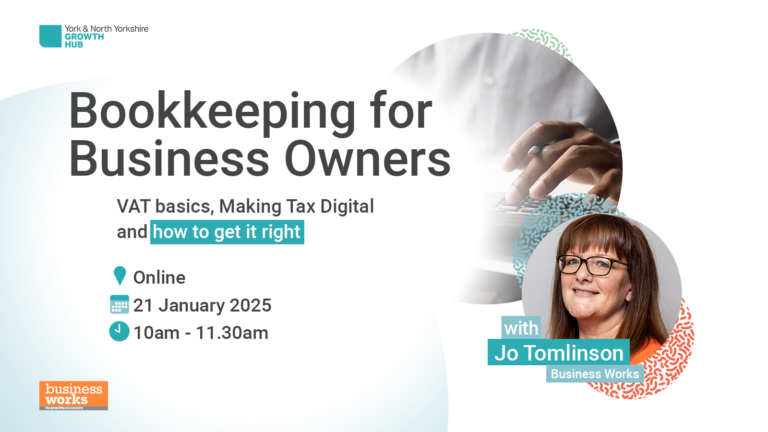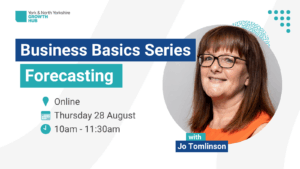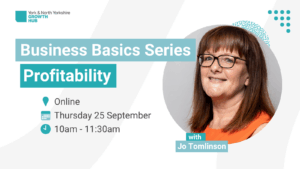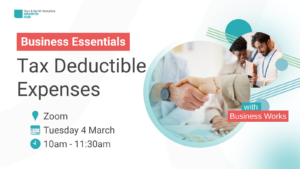Bookkeeping for Business Owners
Business owners often handle their own bookkeeping when they first start out, as they are time-rich but money poor. However, bookkeeping isn’t a skill you acquire simply by registering a business. In fact, earning a bookkeeping qualification takes on average three years to complete. But with a robust process, great software, a little training, and someone to call when you’re unsure, it is possible to do this well, even as a novice.

A Legal requirement
Record keeping is a legal requirement. HMRC can request to see your records at any time by opening an enquiry or investigation, and you are obliged to provide evidence(records) associated with the tax returns you have submitted. You must keep these records for six years, plus the current year.
Having a robust bookkeeping system ensures you have all the records HMRC is likely to request, making any visit much shorter and less stressful.
If you use bookkeeping software in the way I will outline in this document, you are also far less likely to make mistakes that HMRC could identify during an enquiry.
How has Bookkeeping Evolved?
The pace of change in the way bookkeeping is done has been rapid in recent years, with an almost technological revolution taking place.
I remember my Dad sitting at the kitchen table doing his books, with a simplex D ledger book in front of him, handwriting the entries and totalling each page with a calculator. Those were the days when you gave the kitchen a wide berth, as my Dad was always frustrated. Receipts had been lost along the way, and his use of the calculator wasn’t great either. Bookkeeping wasn’t his skill set, and he was doing his best with the tools he had available.
Ledger books were still in use, albeit less widely, when I left University and started my graduate training. The ones I used then had dozens of columns for all of the nominal codes (categories of expense) and the calculator I used came with a till roll, so I could check what I had keyed.
I remember being classed as a revolutionary when I moved these ledgers onto a spreadsheet. This was a big change. The spreadsheet could perform calculations using formulas, and as long as the formulas were correct, the sums were accurate and the process too much less time. This was a significant step forward. Plus, no handwriting was required, a major bonus for me!
In those days, computer-based bookkeeping systems existed, but they were primarily for large businesses with significant budgets. Soon, desktop systems became available, with Sage line 50 leading the way for small businesses. This software came on a floppy disc that arrived in the post, and you installed it on to the computer of whoever was managing the bookkeeping. This was a big step forward. However, there were drawbacks. Many businesses avoided purchasing newer versions, so as the functionality improved over the years, most people stuck with the original version they had bought. Another issue arose then passing the data to an accountant, you were essentially stuck until they had finished with it.
Then came cloud accounting software. Initially, it gained traction slowly, but over the past ten years, it has experienced rapid growth that took many by surprise. So, what has made could accounting/bookkeeping software so popular?
Why use Bookkeeping Software?
Error reduction: Using software significantly reduces the likelihood of errors compared to manual methods or even spreadsheets. The software performs all calculations for you and utilises artificial intelligence to guide you through the process.
Powerful functionality: Receipt Capture is either built into the bookkeeping software or integrated directly with another software or app. When used correctly, receipt capture will:
- Transactions are updated overnight, or even more frequently if required.
- Saves time by eliminating manual entry of bank data.
- Artificial intelligence (AI) recognises previously posted transactions and matches them with bank data, saving a significant amount of time.
Bank Feeds: You can securely link your bank account with the bookkeeping software. The link is read-only, ensuring no-one has access to your money, only transaction details are visible.
- Transactions are updated overnight, or even more frequently if required.
- Saves time by eliminating manual entry of bank data.
- Artificial intelligence (AI) recognises previously posted transactions and matches them with bank data, saving a significant amount of time.
Links to other software: if you use other software in your business. Such as a point-of-sale device, industry specific invoicing software, or software for taking online payments, these can often be linked to your bookkeeping software.
Reporting: You can use the powerful reporting functionality to provide you with a wealth of useful management information, such as:
- Who do you owe?
- Who owes you?
- How are you performing?
Cloud-Based benefits: There are even more advantages when your software is cloud-based, including.
Subscription based: Cloud-based bookkeeping software operates on a subscription basis, meaning you pay monthly. This is easier for cash flow, as no large upfront purchase is required. You always have access to the latest version since updates happen in the cloud continuously. Additionally, the software provider backs up your data, ensuring it is stored safely in case you lose of break your laptop.
Access form anywhere: As long as you have an internet connection, you can access the software on any device. You might use it on your laptop in the office, on an iPad, or even on your phone while out and about. Most providers offer access through an app in addition to the full browser version, making it extremely convenient.
Live, real time information: There’s no need to hand over information to you Accountant at the end of the year. You can provide them with user access, allowing them to login from anywhere. This means they can be working on your year end whilst you continue as normal.
It also enables them to offer real time support. If you are struggling with a transaction, they can see the same screens as you can and guide you through the process.
User access: You can grant customised access to team members, allowing you to delegate aspects of bookkeeping to your team while maintaining control.
A World Class Bookkeeping Process Flow
Just because the process flow I am going to describe is world-class, doesn’t mean it’s hard to follow. We simply need establish some processes, stick to them, and use the right tools for the job.
Some ground rules, before we start. You will need:
- Software: ideally, this should be cloud-based.
- Link up all business-specific bank accounts to the software.
- Integrate any third-party software that connects it.
- Do bookkeeping regularly. Ideally, at least weekly. If you leave it for months, it will:
- Become daunting, making it harder to start.
- Result in lost receipts and forgotten spending details.
- Users: Plan who will handle each task and give them appropriate access to the software.
- Training: Everyone performs better with training on a new tool, no matter what it is.

Step One: Money In
Sales, Revenues, and Income refer to the money we charge for the things we sell, whether goods or services.
When selling goods, or services, income is recognised when it is no longer refundable (we are not considering faulty goods or disputes here). However, it is important to understand this when accounting for deposits. From an accounting perspective, the date the invoice is raised becomes the tax point, unless payment is received before the invoice is issued.
Grants received are also considered income, as is any profit on the sale of assets.
We need all our sales invoices recorded in our bookkeeping software.
- These can be directly created in the software and sent to client from there.
- Converted from estimates or quotes within the software.
- Received from third-party integrated software.
- Imported from third-party software data.
Important Notes:
No changes to sales invoices: Once a sales invoice has been created and sent to a customer or client, it must not be altered.
- If the amount needs increasing, raise a further invoice.
- If the amount needs reducing, raise a credit note.
Invoice numbers: Invoice numbers should be sequential, with no gaps. HMRC does not allow gaps in invoice numbering.
Step Two: Money Out
How do we account for tax deductible expenditures?
Receipts: Wherever possible, ask for and keep receipts. Use receipt capture to save an image of the receipt in your software and replicate the information as a transaction. Whilst OCR Technology helps reduce manual data entry, you must still check the data before saving it.
If you are VAT-registered, you can only reclaim VAT on a valid VAT receipt. A valid VAT receipt should include:
- The VAT registration number of the business.
And ideally,
- The VAT amount and rate clearly split out.
Sometimes, you may need to download receipts from the providers website, for example:
- Amazon
- Subscription services
- Mobile phone contracts
Lost Receipts: If a receipt is lost, you may sometimes use supplementary information such as a bank statement or credit card receipt. However, if you are VAT-registered and looking to reclaim VAT, only a valid VAT receipt will suffice.
Step three: Banking
Always use dedicated bank accounts for your business, and link to your bookkeeping software. This removes the need for manual data entry of banking transactions.
Artificial Intelligence (AI) built into bookkeeping software can identify and match bookkeeping transaction (e.g., invoices or receipts) to bank entries. To do this, the software looks for a like-for-like match. However, if you pay multiple supplier invoices with one payment, the AI will not automatically find the match.
Most software allows you to use something called Rules to allocate banking entries to the correct accounts. this can save a lot of time, but it is essential to set these rules up correctly from the start. Misuse of rules can lead to duplication of entries amongst other issues.
The goal is to allocate all bank entries to transactions and then reconcile the bank account. Reconciliation simply means ensuring that all entries are correctly allocated with nothing left unaccounted for, duplicated, or misallocated.
Once these three steps are complete, we should have up-to-date, accurate business records that can help you run your business and make informed decisions.
It is crucial to process transactions correctly from the outset to:
- Avoid additional accounting fees, as correcting bookkeeping errors can be time-consuming.
- Ensure you submit accurate information to HMRC and pay the correct amount of tax.
Remember: The better the quality of information when it goes in, the better the quality of information when it comes out!
VAT Basics
VAT and bookkeeping are inextricably linked. If you are VAT-registered, you need to set up your bookkeeping software with your VAT number and scheme. This will also require you to input the VAT rate and amount on each transaction into your software.
VAT Registration
- You must register for VAT if your vatable sales/turnover exceeds £90,000 in the last 365 days (or since your business started if less than a year ago).
- You must only charge VAT once you have received your VAT registration number, and this number must be quoted on all of your sales invoices.
- Be aware that it can take a month or more for your VAT registration number to arrive.
Pre-registration VAT reclaim
This is generally done as a journal entry dated as the point of VAT registration. You can claim the VAT on:
- Goods: Up to 4 years prior to registration, provided they are still in the business at the date of registration.
- Services: Up to 6 months prior to registration.
VAT Schemes
There are multiple VAT schemes to choose from. Some are industry-specific, while others are available only to smaller businesses. It’s worth checking which scheme works best for you, as it could save you a significant amount of money.
Accrual Scheme: This is the most commonly used VAT accounting method. VAT is calculated based on the dates of invoices raised (sales) and receipts received (purchases) during the VAT return period.
Cash Scheme: This option is generally preferable if you have customers or clients who are slow payers. VAT is calculated based on the dates payments are made (for purchase) and the dates deposits are received (for sales).
Quarterly Scheme: This is the default for small businesses. HMRC assigns the VAT quarter upon registration, but this can be changed. It’s good practice to align the VAT quarters with your financial year, so you have four full quarters within a tax year.
Monthly Scheme: large companies are required to file monthly VAT returns, but small businesses can opt for this too. Businesses impacted by the VAT reverse charge for CIS often choose monthly returns because regular VAT reclaims improve their cash flow.
Flat Rate Scheme: This scheme aims to simplify the VAT process for small businesses. While it doesn’t always reduce workload, it can save money, so it’s worth checking.
- You can join the scheme if your predicted turnover for the next year is less than £150,000.
- A 1% discount applies in the first year of VAT registration.
Other schemes: There are various other schemes tailored to specific industries or types of supplies.
Making Tax Digital for VAT
This has been a legal requirement for a while now. It requires all VAT returns to be filed digitally via bookkeeping software. You (or your accountant) must complete the registration process for Making Tax Digital (MTD). Filing returns is straightforward once your data is up to date, and all transactions have been correctly entered into your software.
Training
I highly recommend that you loo into some training in using the bookkeeping software you have chosen before you start, or at least early in the process, as this will save you a lot of time and money in the long run. Most software providers provide free resources on their websites.
Sign up to our FREE webinar; Bookkeeping for Business Owners happening on 21 January, 10am-11:30am
Business Basics - Forecasting
Although we don’t have a crystal ball, so forecasts are fundamentally informed guesses, businesses need to use them to make informed business decisions and develop business strategies.
Profitability
Profit is a measure of a business’s income relative to its expenses. In other words, an organisation’s ability to generate revenue by using resources that it has available, such as people, materials and equipment. Unless you are running a charitable organisation, profit is generally the primary goal of a company. As well as providing income for the owners of a business, profits allow for investment and growth. Whilst revenue growth is generally a positive indicator, we need to understand profitability if a business is to be successful.
Business Essentials: What is a Tax Deductible Expense?
As a business owner, it can be daunting when you are trying to work out what you can and can’t claim as tax deductible expense. Other business owners will give you their opinion but is that the right advice for you and your business? You can search online, but this can be confusing and often contradictory. So, what can you claim?
Financial Management – Do you know your numbers?
One of the most important things a business owner should know, is “their numbers”. Do you know how well your business is performing and in which areas? Do you know who you owe and who owes you? Can you afford to make upcoming payments and meet your financial obligations?
Bookkeeping for Business Owners
Business owners often handle their own bookkeeping when they first start out, as they are time-rich but money poor. However, bookkeeping isn’t a skill you acquire simply by registering a business. But with a robust process, great software, a little training, and someone to call when you’re unsure, it is possible to do this well, even as a novice.
Pricing for Maximum Profit
Are you charging enough for your products or services to allow you to provide a service you are proud of and that allows you to not become a busy fool? Are you confident that you are charging the correct price for your goods or services?
Navigating the Latest Budget: A Survival Guide for Small to Medium Businesses
The Budget announced on October 30th will bring substantial changes for many organisations, resulting in increased costs. So, how can we navigate these changes and still maintain profitable businesses?
The importance of having a robust debt collection strategy for your business
Efficient debt collection is a key driver for growth in a business and a fundamental part of operating with healthy cash flows. It’s because, without the cash available when it’s needed to run the business day-to-day, there’s a risk of falling into financial decline.
What are the finance options for a struggling company?
Running a struggling company in financial difficulty is certainly challenging. However, with so many different finance options now available that don’t involve the high street banks, be reassured that you can quickly secure the cash injection you need and get back on track.
How to write a good business plan
Organisations such as the Start-Up Loan Company...
Peer to peer lending Q&A
Looking for an alternative route to financing your business? Peer to peer (P2P) lending is one of the options.
How digital tax will benefit your business
You will probably have heard about digital tax but what does it actually mean for you and how will it benefit your business?













